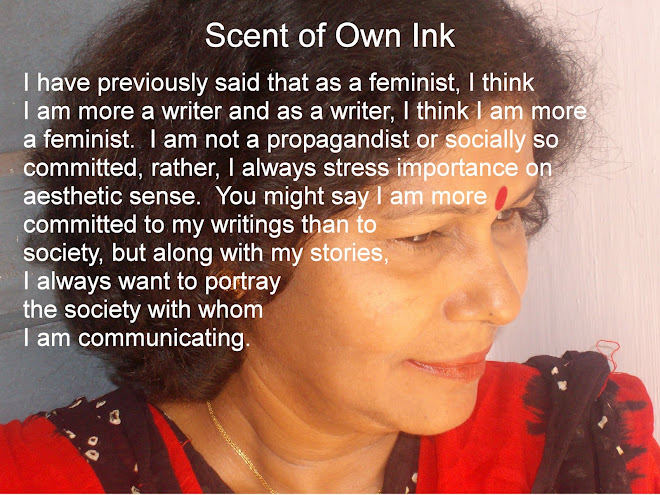 Palm leaf script of Gita Govinda
Palm leaf script of Gita GovindaWhen I started writing in the seventies, very few women writers were in the field and at that time, my theme and topics on sexual politics made the social gurus of the time more worried than ever. That was the time when the cult of domesticity for women started to break down and I raised questions about piety, purity, submissiveness, and the definition of true womanhood through my stories. At that time, I found myself alone, but now, approximately 35 years later, I can see a powerful trend showing published evidence in Oriya literature.
In 2004, young writers began “Dehabadi Galpa,” a movement based on sexuality-based short stories. Saroj Bal, the editor of Galpa Patrika made a collection of short stories where the included authors dared to admit their works had themes of sexuality. Writers included in this anthology included myself and others like Ashish Gadnayak, Saroj Bal, Sadanada Tripathy, Paresh Patnaik, Satyapriya Mahalik, Chintamani Sahu, Paramita Satpathy, Ajay Swain, Pabitra Panigrahi, Nibaran Jena, and Prakash Mohapatra. However, sexuality or erotica had been previously introduced in Oriya literature before this movement in 2004.
For example, the ‘kavyas’ of Ritiyuga in the eighteenth century had deep associations with ‘Shringar Rasa,’ which dealt with sexuality in erotic forms. In the post-colonial period, descriptions of eroticism in a liberal way in fiction was first introduced by Surendra Mohanty. In the sixties, publication of a literary magazine “Uan Neo Lu” included stories by Annada Prasad Ray which were labeled vulgar and obscene. Also in the sixties, Krushna Chandra Behera’s story “Bedi” created controversy and he had to resign from the editorship of Jhankar. In the late eighties, my story “Rape” caused controversy as it dealt with the sexuality of a female and justified it with patriarchal sexual politics. In the nineties, some stories made controversy for making sexuality as a common factor of human life. Pratibha Ray’s “Shapya,” Jagadish Mohanty’s “Nian,” Yashidhara Mishra’s “Rekha Chitra,” and Ashish Gdnaik’s “Bhata” are examples of such stories. In fact, debate about “Nian” continued for long time after its publication.
Another source of long-lasting controversy in Oriya literature was the nude photos of Saroj Bal, the avant-garde Oriya writer. I am still astonished why the media, as well as the critics, considered these photographs as a serious setback in our social values. It is not like masculine nudity was not displayed before, but I think it is the display of masculine nudity in context with Eastern or Oriental culture which worried our male-dominated social gurus. I think, these images have a strong relevance to sexuality.
In Orissa, as well as throughout India, most people mingle sexuality with passion and physical co-adhearance and to some extent, to perversion, with a hidden concept of sin in their puritan minds. But the term ‘sexuality’ has a wider aspect. Sexuality involves not only passion and perversion, but also involves biological or physiological sex, gender, gender identity, gender roles, and sexual orientation.
Sexuality, other than sexual politics, occupies a space in Oriya fiction which is neither quite masculine nor quite feminine, although it is clearly created as a feminine role and desires to be in the masculine role. Currently, we find a remarkable number of women authors writing very bold stories describing this ‘in-between-ness’ as being one of the primary characteristics of their themes and styles. Writers like Paramita Satpathy Tripathy, Mamatamayee Choudhury and Biyot Prajna Tripathy are some new faces who write effectively connecting this in-between-ness as both a monstrous trait and a gorgeous one as well.
Unlike fiction, Oriya poetry supports this sexual discourse. Different from other poets, Aparna Mohanty’s poems represent a blurring of the distinction between man and monster, between nature and science, and of gender categories themselves. Aparna’s poems recognise and celebrate the presence of pure womanhood and feminine attributes in the construction of being in existence in a woman’s heart. Other than Aparna, Gayatri Bala Panda, Sucheta Mishra, and Sarojini Sarangi are among a few poets who have contributed to make Oriya poems rich with sexual domination.
It is interesting that mostly women writers are coming forward in riding the wave of popular interest in women's liberation, identifying taboos as a socially conditioned belief system, masquerading as nature. It is a very sensible and risky notion to demonstrate the truth of life exceeding the body and its passion. Though this segment is limited to few, it could make it as a mainstream wave, though the major puritan mob will always oppose it.
( Published in my regular monthly column at New Indian Express, in its 22 May issue)
